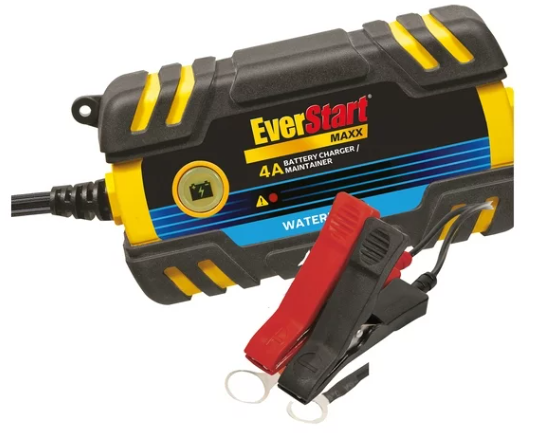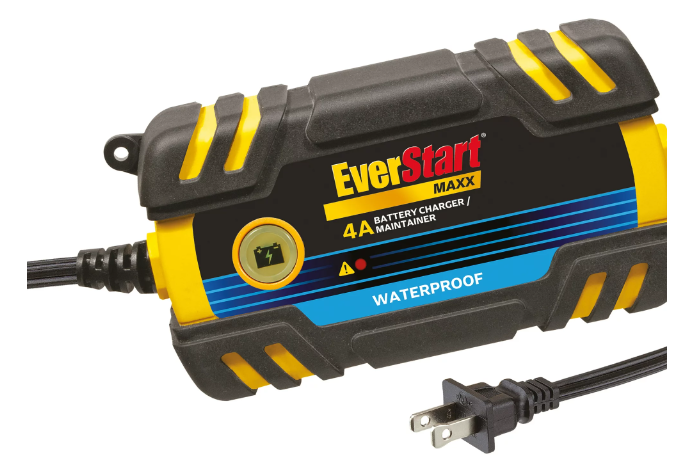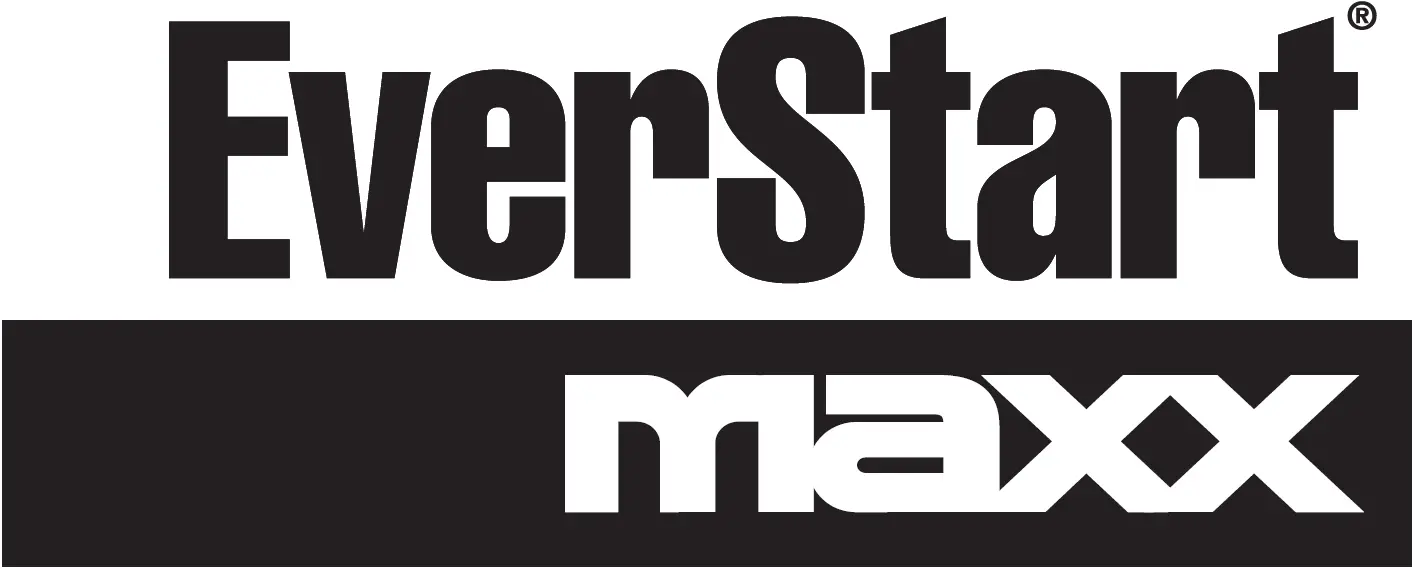
EverStart Maxx BC4WE 4 Amp Battery Charger
About Everstart
Johnson Controls produces EverStart batteries. These are high-quality, long-lasting, and low-maintenance. The EverStart series offers both AGM and lead-acid batteries. The most popular AGM (absorbed glass mat) battery models are EverStart Plus and EverStart Maxx.
Visit: EverStart Maxx EL224 600 Amp Lithium-ion Jump Starter or EverStart SL097 Jump Starter
FEATURES
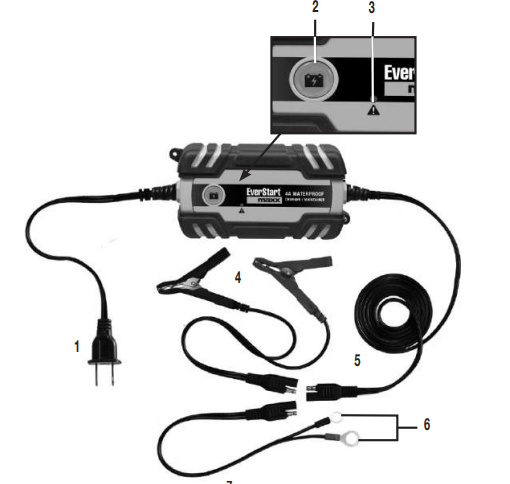
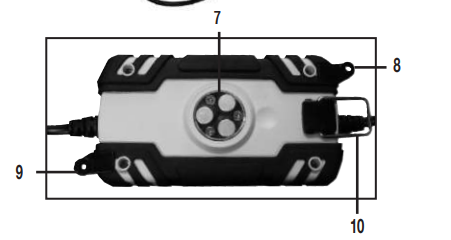
- AC Power Cord
- Charging / Charged LED
- Reverse Polarity LED
- Battery Clamps
- Double Barrel Charger Connector (connects to terminal rings, and clamps)
- Battery Terminal Rings
- Magnetic Discs (exposed to show detail)
- Mounting Bracket
- Mounting Bracket
- Hanging Hook
SAFETY GUIDELINES
- DANGER: Indicates an imminently hazardous situation that, if not avoided, will result in death or serious injury.
- WARNING: Indicates a potentially hazardous situation which, if not avoided, could result in death or serious injury.
- CAUTION: Indicates a potentially hazardous situation which, if not avoided, may result in minor or moderate injury.
- CAUTION: Used without the safety alert symbol indicates potentially hazardous situations which, if not avoided, may result in property damage.
- RISK OF UNSAFE OPERATION. When using tools or equipment, basic safety precautions should always be followed to reduce the risk of personal injury. Improper operation, maintenance, or modification of tools or equipment could result in serious injury and property damage. There are certain applications for which tools and equipment are designed. The manufacturer strongly recommends that this product NOT be modified and/or used for any application other than for which it was designed. Read and understand all warnings and operating instructions before using any tool or equipment.
READ ALL INSTRUCTIONS
WARNING: Read and understand this instruction manual before using this unit. Failure to follow all instructions listed below may result in electric shock, fire, and/or serious injury.
IMPORTANT SAFETY INSTRUCTIONS
GENERAL SAFETY WARNINGS AND INSTRUCTIONS
- Keep children away. Keep away from children. This is not a toy!
- Store indoors. When not in use, battery chargers should be stored indoors in dry, and high or locked-up places – out of reach of children.
- Unplug the battery charger when not in use.
SPECIFIC SAFETY INSTRUCTIONS FOR POWER CORDS
- Don’t abuse the cord. Never carry the home appliances by a cord or yank them to disconnect from the receptacle. Keep cord from heat, oil, and sharp edges. Pull by plug rather than cord when unplugging the unit.
- Ground Fault Circuit Interrupter (GFCI) protection should be provided on the circuits or outlets to be used. Receptacles are available having built-in GFCI protection and may be used for this measure of safety.
Extension cords - An extension cord should not be used unless necessary. The use of improper extension cords could result in a risk of fire and electric shock. If an extension cord is used, make sure that the pins of the extension cord are the same number, size, and shape as those in the charger.
- Make sure your extension cord is in good condition. When using an extension cord, be sure to use one heavy enough to carry the current your product will draw. An undersized cord will cause a drop in line voltage resulting in loss of power and overheating. The following table shows the correct size to use depending on cord length and nameplate ampere rating. If in doubt, use the next heavier gauge. The smaller the gauge number, the heavier the cord.
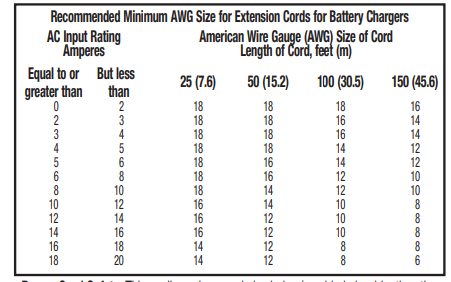
- Power Cord Safety: This home appliance has a polarized plug (one blade is wider than the other) as a safety feature. This plug will fit into a polarized outlet only one way. If the plug does not fit fully into the outlet, reverse the plug. If it still does not fit, contact a qualified electrician. Do not attempt to defeat this safety feature.
SPECIFIC SAFETY INSTRUCTIONS FOR BATTERY CHARGERS
- This unit was designed for household use only.
- Use of accessories and attachments: The use of any accessory or attachment not recommended by the manufacturer for use with this battery charger could be hazardous.
- Stay alert. Use common sense. Do not operate this equipment when you are tired or impaired.
- Check for damaged parts. A part that is damaged should be properly repaired or replaced by the manufacturer before further use unless otherwise indicated elsewhere in this instruction manual.
- Do not operate the battery charger near flammable liquids or in gaseous or explosive atmospheres. Motors may spark, and the sparks might ignite fumes.
- Do not operate the battery charger if it has received a sharp blow, been dropped, or has been otherwise damaged in any way. Return it to the manufacturer for repair.
WARNING – Burst hazard:
- Do not use the unit for charging dry-cell batteries that are commonly used with home appliances. These batteries may burst and cause injury to persons and damage property. Use the unit for charging/boosting a 12-volt LEAD-ACID battery only. It is not intended to supply power to a low-voltage electrical system other than in a starter-motor application.
- Never attempt to charge non-rechargeable batteries.
WARNING – Risk of explosive gases:
- WORKING IN THE VICINITY OF A LEAD-ACID BATTERY IS DANGEROUS. BATTERIES GENERATE EXPLOSIVE GASES DURING NORMAL BATTERY OPERATION. FOR THIS REASON, IT IS OF THE UTMOST IMPORTANCE THAT EACH TIME BEFORE USING THE BATTERY CHARGER YOU READ THIS MANUAL AND FOLLOW INSTRUCTIONS EXACTLY.
- To reduce the risk of battery explosion, follow these instructions and those published by the battery manufacturer and manufacturer of any equipment you intend to use in the vicinity of the battery. Review cautionary markings on these products and on the engine.
- This equipment employs parts (switches, relays, etc.) that produce arcs or sparks. Therefore, if used in a garage or enclosed area, the unit MUST be placed not less than 18 inches above the floor.
- THIS UNIT IS NOT FOR USE BY CHILDREN AND SHOULD ONLY BE OPERATED BY ADULTS.
WARNING – TO REDUCE THE RISK OF FIRE:
- Do not operate near flammable materials, fumes, or gases.
- Do not be exposed to extreme heat or flames.
CAUTION – TO REDUCE THE RISK OF INJURY OR PROPERTY DAMAGE:
- This charger is not designed for use with every make, manufacturer, or model of engine. Use only with 12-volt systems.
- NEVER ATTEMPT TO CHARGE A FROZEN BATTERY.
- Do not charge the battery while the engine is operating.
- Stay clear of fan blades, belts, pulleys, and other parts that can cause injury to persons.
- Vehicles that have on-board computerized systems may be damaged if the vehicle battery is jump-started. Before jump-starting, read the vehicle’s owner’s manual to confirm that external-starting assistance is suitable.
- When working with lead acid batteries, always make sure someone is close enough to provide immediate assistance in case of an accident or emergency.
- Always have protective eyewear when using this product: contact with battery acid may cause blindness and/or severe burns. Be aware of first aid procedures in case of accidental contact with battery acid.
- Have plenty of fresh water and soap nearby in case battery acid contacts the skin.
- If battery acid contacts skin or clothing, wash immediately with soap and water for at least 10 minutes and get medical attention immediately.
- Never smoke or allow a spark or flame in the vicinity of the vehicle battery, engine, or battery maintainer.
- Remove personal metal items such as rings, bracelets, necklaces, and watches when working with a lead acid battery. A lead acid battery can produce a short circuit current high enough to weld a ring, or similar metal object, to skin causing a severe burn.
- Be extra cautious to avoid dropping a metal tool onto the battery. It might spark or short-circuit the battery or another electrical part, and that may cause an explosion.
- Never allow battery acid to come in contact with this unit.
- Do not operate this unit in a closed area or restrict ventilation in any way.
- Always turn the battery charger off by unplugging it when not in use.
- Do not open the battery charger — there are no user-serviceable parts inside. Opening the battery charger will void the manufacturer’s warranty.
- Operate battery charger only as described in this Instruction Manual.
- Check the battery charger and components periodically for wear and tear without disassembling the unit. Return to manufacturer for replacement of worn or defective parts immediately.
SPECIFIC SAFETY INSTRUCTIONS FOR USING THE UNIT IN WET ENVIRONMENTS
The housing of this unit is rated to IP67 dust-proof and waterproof standards. However, it is recommended that you observe the following:
- Never submerge the unit in water deeper than 1 meter, for a time longer than 30 minutes, and/or in temperatures other than between 41ºF and 104ºF (5ºC and 40ºC), or the unit could sustain permanent damage.
- Never submerge the unit in water unless the bushing (insulation) of the AC or DC cord is intact.
- Do not allow clamps to be exposed to the elements for long periods; and never submerge them.
FIRST AID
- SKIN: If battery acid comes in contact with the skin, rinse immediately with water, then wash thoroughly with soap and water. If redness, pain, or irritation occurs, seek immediate medical attention.
- EYES: If battery acid comes in contact with your eyes, flush your eyes immediately, for a minimum of 15 minutes, and seek immediate medical attention.
- WARNING – To reduce the risk of injury or property damage: Follow these instructions and those published by the manufacturer of any engine you intend to use with this battery charger. Review cautionary markings on the battery charger and engine. Read and Understand This Instruction Manual Before Using This Unit.
SAVE THESE INSTRUCTIONS
WARNING – To reduce the risk of injury:
Follow these instructions and those published by the battery manufacturer and manufacturer of any equipment you intend to use with this unit. Review cautionary markings on these products and the engine.
PREPARING TO CHARGE
- Be sure the area around the battery is well-ventilated while the battery is being charged.
- Remove the battery completely from the boat/airplane or any confined area before charging.
- If it is necessary to remove the battery from the vehicle to charge, or to clean terminals, always remove the grounded terminal from the battery first. Make sure all accessories in the vehicle are off, so as not to cause an arc.
- Clean battery terminals, taking care to avoid getting corrosive material in the eyes.
- Add distilled water in each cell until battery acid reaches the level specified by the battery manufacturer. This helps purge excessive gas from cells. Do not overfill. For
a battery without cell caps (maintenance-free), carefully follow the manufacturer’s charging instructions. - Study all battery manufacturer’s specific precautions, such as removing or not removing cell caps while charging, and recommended rates of charge.
- Determine the voltage of the battery to be charged by referring to the vehicle manual. The unit is for charging a 12-volt battery only.
CHARGER LOCATION
- Locate the charger as far away from the battery as the cables permit.
- Never place the charger directly above the battery being charged; gases from the battery will corrode and damage the charger.
- Do not set a battery on top of the charger.
- Never allow battery acid to drip on the charger.
- Charge above freezing temperature and below 40°C (104°F).
- Never operate the charger in a closed-in area or restrict ventilation in any way.
- Marine batteries must be removed and charged on shore.
CONNECTION PRECAUTIONS
- Never allow clamps or ring terminals to touch each other.
- Attach clamps to the battery and chassis as indicated in the appropriate section
(“Charging a battery installed in a vehicle” or “Charging a battery that has been removed from a vehicle”).
CHARGING A BATTERY INSTALLED IN A VEHICLE
WARNING: A spark near the battery may cause an explosion. To reduce the risk of a spark near the battery:
- Position AC and clamp cords to reduce the risk of damage by hood, door, or moving engine part.
- Stay clear of fan blades, belts, pulleys, and other parts that can cause injury to persons.
- Check the polarity of battery posts. POSITIVE (POS, P, +) battery post usually has a larger diameter than NEGATIVE (NEG, N, –) post.
- Determine which battery post is grounded (connected) to the chassis. If the negative post is grounded to the chassis (as in most vehicles), see 5. If the positive post is grounded to the chassis, see 6.
- For a negative-grounded vehicle, connect the POSITIVE (RED) clamp from the battery charger to the POSITIVE (POS, P, +) ungrounded post of the battery. Connect a NEGATIVE (BLACK) clamp to the vehicle chassis or engine block away from the battery. Do not connect the clip to the carburetor, fuel lines, or sheet-metal body parts. Connect to the heavy gauge metal part of the frame or engine block.
- For positive-grounded vehicle, connect NEGATIVE (BLACK) clamp from battery charger to NEGATIVE (NEG, N, –) ungrounded post of battery. Connect POSITIVE (RED) clamp to vehicle chassis or engine block away from battery. Do not connect clip to carburetor, fuel lines or sheet-metal body parts. Connect to a heavy gauge metal part of the frame or engine block.
- See operating instructions for length of charge information.
When disconnecting charger, disconnect AC Power cord, remove clamp from vehicle chassis, and then remove clamp from battery terminal.
CHARGING A BATTERY THAT HAS BEEN REMOVED FROM A VEHICLE
WARNING – A spark near the battery may cause an explosion. To reduce risk of a spark near the battery:
- Check polarity of battery posts. The Positive post (marked POS,P, +) usually has a larger diameter than the Negative battery post (marked NEG, N, –).
- Attach a 24-inch (minimum length) AWG #6 insulated battery cable to the Negative battery post (marked NEG, N, –).
- Connect the Positive (RED) battery clamp to the Positive battery post (marked POS, P, + or red).
- Stand as far back from the battery as possible, and do not face battery when making final connection.
- Carefully connect the NEGATIVE (BLACK) charger clamp to the free end of the battery cable connected to the negative terminal.
Note: A marine (boat) battery must be removed and charged on shore. To charge it on board requires equipment specifically designed for marine use. This unit is NOT designed for such use.
When disconnecting the charger, always do so in reverse sequence of connecting procedure and break first connection while as far away from battery as practical.
Visit: EverStart MAXX BC50BE 15 Amp Automotive Battery Charger
SETTING UP THE UNIT
Mounting the Battery Charger
This battery charger is designed so that it can be mounted on a flat surface. The unit has two mounting backets at the corners of the unit.
CAUTION – To reduce the risk of product damage:
- Ensure that all installation and operating instructions and safety precautions are understood and carefully followed by anyone mounting or using the battery charger. Follow the steps outlined in the “Important Safety Instructions” section of this manual.
- Always disconnect the charger at AC power source and at battery terminal before mounting the unit.
- When the battery charger is mounted, do not hang anything additional on the battery charger or risk of breakage may occur.
- Position the unit as desired on a flat wall surface near a functioning AC outlet. Make sure the surface is flat and free of obstruction so the unit rests flush with the surface.
- Use an 8/32-inch (6.35mm) wood screw through each of the mounting brackets to mount the unit. Do not over-tighten as this will damage the housing.
WARNING: Do not put the screw through the plastic housing of the unit as this will permanently damage the unit and cause a potential electrical hazard.
To mount the unit Using the Magnetic Discs
The magnetic discs in the bottom of the unit allow you to position the battery charger on any flat, secure metallic surface.
Using the Hanging Hook
The hanging hook can also be used to conveniently position the unit.
CAUTION – To reduce the risk of product damage:
- When the charger is hung by the hanging hook or attached using the magnetic discs, do not shake the charger or object that it is hanging from or attached to. Do not hang the charger from or attach the charger to any electrical wires or anything that it is not secure.
- Only use the hanging hook or magnet discs for hanging or positioning the charger. The hanging hook and magnetic discs are not intended to support the additional weight. Do not attach or hang anything additional to the charger or risk of breakage may occur.
OPERATING INSTRUCTIONS
WARNING – To reduce the risk of injury or property damage:
- Always disconnect the AC plug from the AC outlet first before disconnecting the charger from the battery to be charged.
- Ensure that all installation, operating instructions and safety precautions are understood and observed; then follow the steps outlined in the appropriate section (“Charging a battery installed in a vehicle” or “Charging a battery that has been removed from a vehicle”).
CHARGING USING THE SUPPLIED BATTERY CLIPS
The charger’s output leads have color-coded battery clamps (RED–POSITIVE and BLACK–NEGATIVE).
- Make sure the battery charger is unplugged from any power source and is not connected to a battery.
- Insert the double barrel tip of the battery clamp cable into the unit’s Double Barrel Charger Connector (male-to-female and female-to-male).
- Connect the battery clamps to the battery and position the unit as far away from the battery as possible, following the appropriate directions in the “Preparing to Charge” Section at the front of this manual.
- Insert the AC plug of the battery charger into a (powered) standard North American 120 volt 60Hz outlet. The Charging/Charged LED will flash green to indicate the unit is in charging mode.
Notes: If the clamps are incorrectly connected with regard to polarity, the Reverse Connection LED will light. Unplug the charger; then remove the clamps. Reconnect the clamps properly. If the Charging/Charged LED did not come on, check the connection to the battery and the AC outlet. If the clamps are properly connected to the battery and a functional AC outlet, the battery may be in fault condition. The instruction manual Manufacturer suggests to have the battery tested by a qualified battery service technician. - When the Charging/Charged LED lights solid, the charging process is complete.
When disconnecting the battery charger, first unplug the AC cord, remove the clamp from the vehicle chassis, and then remove the clamp from the battery terminal.
Visit: EverStart Maxx BC40BE 40 Amp Automotive Bench Battery Charger
CONNECTING AND CHARGING WITH THE TERMINAL RINGS
Connecting
The charger’s output leads have crimped, color-coded terminal rings (RED-POSITIVE and BLACK-NEGATIVE). These rings connect directly to the corresponding connectors on the battery posts. Connecting

- Remove the nuts from the bolts of the battery post’s connectors.
- Position the RED terminal ring on the bolt of the POSITIVE battery post connector.
- Position the BLACK terminal ring on the NEGATIVE post connector; then replace the nuts.
IMPORTANT: If there is any problem connecting the output leads, check with a reputable auto supply store or contact the Customer Service Department toll-free at 1-877-571-2391 for assistance in finding an appropriate connection device for your particular application.
Charging With the Terminal Rings
- Make sure the battery charger is unplugged from any power source and is not connected to a battery.
- With the Terminals Rings properly connected to the battery posts, connect the Terminal Ring connector with the unit’s Double Barrel Charger Connector (male-to-female and female-to-male) and position it as far away from the battery as possible.
- Insert the AC plug of the battery charger into a (powered) standard North American 120 volt 60Hz outlet. The Charging/Charged LED will flash green to indicate the unit is charging mode.
Notes: If the Terminal Rings are incorrectly connected with regard to polarity, the reverse polarity LED will light. Disconnect the charger, disconnect the Terminal Rings, then reconnect them properly.
If the Charging/Charged LED did not come on, check the connection to the battery posts and the AC outlet. If the Terminal Rings are properly connected to the battery posts and a functional AC outlet, the battery may be in fault condition. Manufacturer suggests to have the battery tested by a qualified battery service technician. - When the Charging/Charged LED lights solid, the charging process is complete. When disconnecting charger, disconnect AC cord, and then remove the Terminals Rings from the battery posts.
CARE AND MAINTENANCE
Cleaning and Storage
To reduce the risk of electric shock, unplug the battery charger from the outlet before attempting any maintenance or cleaning. Turning off the controls will not reduce this risk.
- Store the unit in a clean, dry, cool place when not in use.
- Clean the unit casing and cords (as necessary) with a dry (or slightly damp) cloth. Ensure that unit is completely disconnected from battery and power source before cleaning.
- To maintain the operating condition and maximize the life of the charger cords, always coil them loosely for storage. Do not wrap them around the unit or crimp them with a tight band.
Visit: EverStart maxx EL224 600 Amp Lithium-ion Jump Starter
TROUBLESHOOTING

ACCESSORIES
Recommended accessories for use with this unit may be available from the manufacturer. If you need assistance regarding accessories, please contact manufacturer at 1-877-571-2391.
WARNING: The use of any accessory not recommended for use with this home appliances could be hazardous.
SERVICE INFORMATION
Whether you need technical advice, repair, or genuine factory replacement parts, contact the manufacturer at 1-877-571-2391.
TWO-YEAR LIMITED WARRANTY
The manufacturer warrants this product against defects in materials and workmanship for a period of TWO (2) YEARS from the date of retail purchase by the original end-user purchaser (“Warranty Period”). If there is a defect and a valid claim is received within the Warranty Period, the defective product can be replaced or repaired in the following ways: (1) Return the product to the manufacturer for repair or replacement at manufacturer’s option. Proof of purchase may be required by manufacturer. (2) Return the product to the retailer where product was purchased for an exchange (provided that the store is a participating retailer).
Returns to retailer should be made within the time period of the retailer’s return policy for exchanges only (usually 30 to 90 days after the sale). Proof of purchase may be required. Please check with the retailer for their specific return policy regarding returns that are beyond the time set for exchanges. This warranty does not apply to accessories, bulbs, fuses and batteries; defects resulting from normal wear and tear, accidents; damages sustained during shipping; alterations; unauthorized use or repair; neglect, misuse, abuse; and failure to follow instructions for care and maintenance for the product.
This warranty gives you, the original retail purchaser, specific legal rights and you may have other rights which vary from state to state or province to province. This product is not intended for commercial use.
APPENDIX
This device complies with part 15 of the FCC rules. Operation is subject to the following two conditions: (1) this device may not cause harmful interference, and (2) this device must accept any interference received, including interference that may cause undesired operation.
This equipment has been tested and found to comply with the limits for a Class B digital device, pursuant to part 15 of the FCC Rules. These limits are designed to provide reasonable protection against harmful interference in a residential installation. This equipment generates, uses and can radiate radio frequency energy and, if not installed and used in accordance with the instructions, may cause harmful interference to radio communications. However, there is no guarantee that interference will not occur in a particular installation.
If equipment does cause harmful interference to radio or television reception, which can be determined by turning the equipment off and on, the user is encouraged to try to correct the interference by one or more of the following measures:
- Reorient or relocate the receiving antenna.
- Increase the separation between equipment and receiver.
- Connect the equipment into an outlet on a circuit different from that to which the receiver is connected.
- Consult the dealer or an experienced radio/TV technician for help.
Changes or modifications not approved by the party responsible for compliance could void user’s authority to operate the equipment.
SPECIFICATIONS
- Input: 120V AC, 60Hz, 0.9A
- Output: 12V DC, 4A
Imported by Baccus Global LLC,
621 NW 53rd St., Suite 450, Boca Raton, FL 33487
www.Baccusglobal.com 1-877-571-2391
Visit: EverStart JUS750CE Jumper Starter
FAQ’S about EverStart Maxx BC4WE 4 Amp Battery Charger
Q: How long does it take to fully charge a battery using an EverStart Maxx BC4WE 4 Amp Battery Charger?
A: 51 amp/hours are mine. 51 divided by the charging rate of 1.25 amps per hour indicates that 40.8 hours were needed to charge the battery fully and 32.6 hours were needed to charge it to 80% so it could be used.
Q: How much time does EverStart Maxx BC4WE 4 Amp Battery Charger require to fully charge?
A: The Everstart Maxx alternator typically needs 40.8 hours to completely charge a battery.
Q: What does the green flickering on your portable charger mean?
A: There has been a temperature variation if your charger’s charging LED is flashing green. It’s possible that the battery is too cold or hot to use or charge. The following can be done to fix this: Allow the battery to warm up or cool down.
Q: How can I tell when a battery on a charger is fully charged?
A: Once the current has been stable at a low level for a few hours, the battery is fully charged. The final current level and the peak charging voltage, when this current is flowing, are the two factors that determine whether a battery is fully charged.
Q: How can you tell when a battery charger for cars is done?
A: 5 hours following the completion of the battery’s external or internal charging (by charger or alternator), or following at least an hour of discharge. When the current reaches zero, stops decreasing, or the automatic charger shuts off by itself, the battery is said to have fully charged.
Q: How long does it take to charge a battery using a EverStart Maxx BC4WE 4 Amp Battery Charger?
A: It will take roughly 10–24 hours to fully charge a standard automotive battery with an usual charge amp of 4–8 amperes. It would take about 2-4 hours to sufficiently charge your battery so that you could start the engine. Recharging carefully is the greatest strategy to ensure that your car battery lasts a long time.
Q: Why can’t a dead battery be charged by my EverStart Maxx BC4WE 4 Amp Battery Charger?
A: The charger won’t recognize a functional battery hookup and won’t pass current if the battery voltage is below the specific level of the charger. Some chargers display a fault mode (constant flashing), while others are completely inactive.
Q: What is the turnaround time for a 12-volt battery?
A: Remember that if you use a slow charger, the battery charging time should be between 10 and 12 hours. On the other side, if you use a quick charger you can recharge it in less than 6 hours. It is a much better choice to measure the battery levels with a voltmeter while charging in order to get the best results.
Q: When they are full, do portable chargers stop charging?
A: Yes, the power bank’s intelligent circuitry regulates the battery’s charge. The battery stops charging when it is fully charged. A separate inbuilt circuit will automatically stop charging the battery once it is fully charged if the smart circuitry fails.
Q: How can I stop using my Everstart Maxx jump starter?
A: When you press the USB and LED buttons repeatedly until their lights are not on, the device should turn off on its own.
Q: Can an EverStart Maxx BC4WE 4 Amp Battery Charger remain turned on?
A: Yes. When storing the application, we advise users to keep the chargers for the batteries and AC plugged in. The charger will start checking the batteries’ voltage as soon as it has finished charging them. Lead-acid batteries gradually self-discharge, and the rate of self-discharge rises with battery aging.
You may also wish to visit more vehicle battery-related manuals by Everstart
- EverStart Maxx BC40BE 40 Amp Automotive Bench Battery Charger
- EverStart MAXX BC50BE 15 Amp Automotive Battery Charger
- EverStart MAXX PPS1CWE 1000 Amp Jump Starter
- EverStart SL097 Jump Starter

